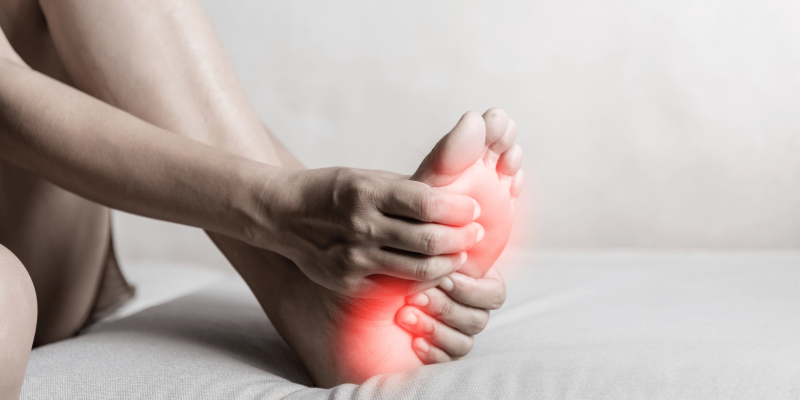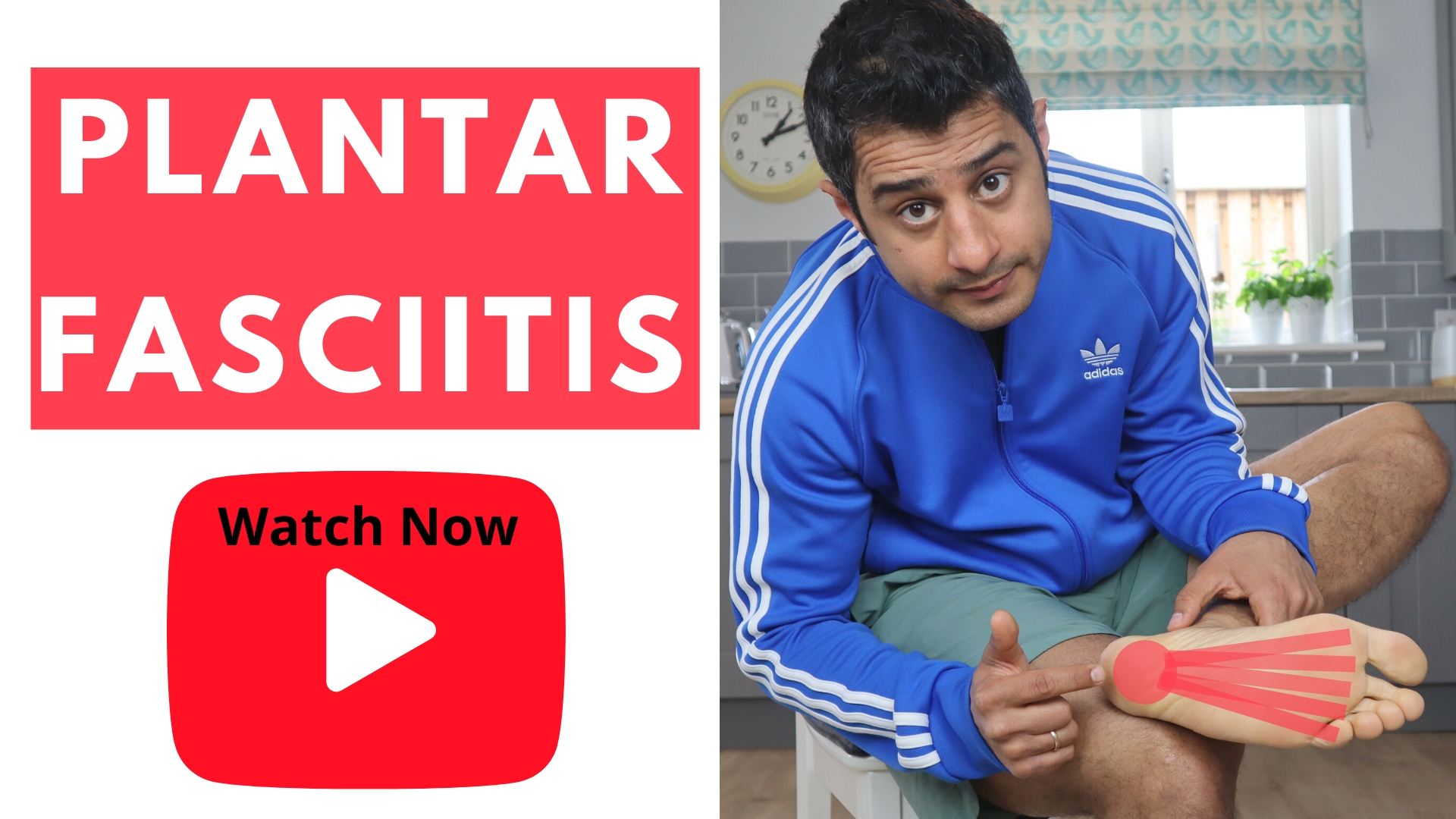Plantar fasciitis means inflammation of your plantar fascia, a strong band of tissue that stretches from your heel to your middle foot bones. The plantar fascia is not really a tendon, it’s a sheet of connective tissue that we call (fascia).
Plantar fascia It is more like a ligament than a tendon. It stretches from the heel to toes, spanning the arch of the foot, from bones at the back to bones at the front (whereas tendons connect muscles to bones). It supports the arch of your foot and also acts as a shock absorber in your foot.
Plantar fasciitis is a common and often persistent kind of repetitive strain injury afflicting runners, walkers and hikers, and nearly anyone who stands for a long time, especially on hard surfaces. It is most common in people between the ages of 40 to 60 years. However, it can occur at any age. It is twice as common in women as men.
Symptoms
Pain tends to be felt in the sole of the foot with tenderness on palpating (touching with your fingers) the medial part of the heel bone. Usually, the first few steps in the morning are painful but this gradually settles down as you continue walking. A couple of activity such as, running, walking barefoot or on your toes and going upstairs all tend to aggravate your pain.
What is the cause of Plantar Fascitis?
Plantar fasciitis means inflammation of your plantar fascia. However, the main cause of Plantar Fasciitis is not fully understood. Research has shown this isn’t a condition that usually involves inflammation so the term Plantar Fasciitis is probably not the best way to call it. Repetitive overload to the fascia (with or without inflammation) thought to be a factor that leads to plantar fasciitis. The injury is usually near to where the plantar fascia attaches to your heel bone.
What are the Risk factors for Plantar Fascitis?
Any factor that mechanically loads the plantar fascia can be considered a risk factor for plantar fasciitis. Risk factors can be divided into intrinsic and extrinsic factors. Intrinsic factors relating to the patient include obesity, excessive foot pronation or high Arches, reduced range of ankle dorsiflexion and tight calf muscles (Read More). Extrinsic factors, relating to the environment and training, include running on hard surfaces, walking barefoot, a sudden increase in running intensity and/or volume, and prolonged walking/standing (Read More).
Lack of ankle Dorsiflexion
Research has shown, the risk of plantar fasciitis increases as the range of ankle dorsiflexion decreases. Limited ankle dorsiflexion creates a lack of movement needed to assist in absorbing of ground reaction forces. This results in an inability to dissipate the forces once they place their foot on the ground placing this excessive load on the plantar fascia (Read more).
High BMI
Individuals who spend the majority of their workday on their feet and those whose body-mass index is >30 kg/m are also at increased risk for the development of plantar fasciitis (Read more).
Training Volume / Overused
In athletes mostly runners, plantar fasciitis appears to be associated with overuse. In Addition, sudden increases in weight-bearing activity, particularly those involving running, can cause microtrauma to the plantar fascia at a rate that exceeds the body’s ability to recover (Read more)
Excessive foot pronation / High Arches
Normally, when the foot lands on the ground it rolls slightly inward or pronates. A person who pronates too much, however, puts extra pressure on the inner foot, which can strain the plantar fascia. Excessive foot pronation is common in people who have flat feet – pes planus (Read more). However, on the other hand, research highlighted as a biomechanical link patient with high arches could have a higher chance of having plantar fasciitis (Read more).
Tight Calves
Research has shown tight calves are another risk factor for plantar fasciitis. Increasing tension on the Achilles tendon is coupled with an increasing strain on the plantar fascia. In other words, tight gastrocnemius and soleus muscles certainly can put a strain on the plantar fascia. “Overstretching of the Achilles tendon resulting from intense muscle contraction and passive stretching of tight Achilles tendon are plausible mechanical factors for overstraining of the plantar fascia” (Read more)
Do you need an X-ray or MRI Scan?
The short answer is no. The X-rays or MRI are not the best diagnostic tools for Plantar Fascitis. Usually, it can be diagnosed through your history and examination. You may need further investigation to role out any differential diagnosis (something else that could be causing the pain).
Treatment for Plantar Fascitis
Treatment is largely nonoperative, with up to 90%–95% of patients will improve their symptoms within 12–18 months.
I have prepare a series of tips and exercises to follow to manage your plantar fasciitis. Watch the video below and feel free to leave me a comment.
Activity Modification / Cross Training
The 1st step of your treatment will be a modification of your daily activities, while those that involve repetitive impact, such as running (even on a treadmill), should be avoided during the treatment phase. You can continue performing non-weight-bearing activities such as cycling, swimming, and rowing to maintain your cardiovascular fitness while minimizing loading. The 2nd step would be a gradual return to activity will be allowed after your symptoms are calm down for 4–6 weeks and no longer has localized tenderness over the plantar fascia.
Plantar Fascia Stretch
Plantar fascia and calf stretches will be performed daily. The plantar fascia-specific stretch has been shown to be more efficacious than the isolated Achilles stretching programme (Read more).
“The plantar fascia-specific stretch is performed by dorsiflexing the toes with one hand (taking advantage of the windlass mechanism) and palpating the plantar fascia with the other hand to ensure that it is taught”. The stretch is held for a count of 30 seconds and repeated at least three times in each session. This should be done daily, especially before taking the first step in the morning and before standing following a period of prolonged sitting. In the latest research by Digiovanni, patients were instructed to perform the stretch 10 times, for 10 seconds, three times per day (Read more).
Strength Training
Strengthening the plantar fascia will be part of your treatment plan. Depend on the individual symptoms, we prescribe a routine of strengthening exercises. You can contact us if you have any question (Contact us).
Our Approach
Dublin Sports Injury Clinics a Physical Therapy Clinic based in Fitzwilliam Square, Dublin2. We have a holistic approach to our assessment and treatment. The initial assessment helps us to explore the cause of your injury and help you to get pain free shortly and stop any further injuries. We design a customized training program for you to start with, and we coach and monitor your progress closely. Our Therapist prescribes relative rest or modified activities as required. Depending on the individual requirement, we apply manual therapy accompanied by a home-based training program to maximize your recovery.
Next step
Want to get in touch with our team of the therapist or you are looking for some advice? Simply fill in your details below & we get in touch with you shortly.
FOLLOW US ON YOUTUBE AND GET ACCESS TO OUR WEEKLY FREE REHABILITATION EXERCISES.
Disclaimer: This article is for information only and should not be used for the diagnosis or treatment of medical conditions. You can contact us if you would like to book an appointment or get some advice from our therapist.



5 Responses
Great tips, I have had this issue in the past and I found these exercises specially the stretch, can help a lot. Good work
Thank you for this routine, I found this routine really helpful with my sore back. I’ve tried it between calls and zoom meetings for a week and I feel much better. Thanks again.
Thanks for the exercises and the tips. My PF feels better after trying this for 3 consequent days.
I have read several good stuff here. Certainly value bookmarking for revisiting.
I wonder how a lot of effort you put to make one of these magnificent informative web site.